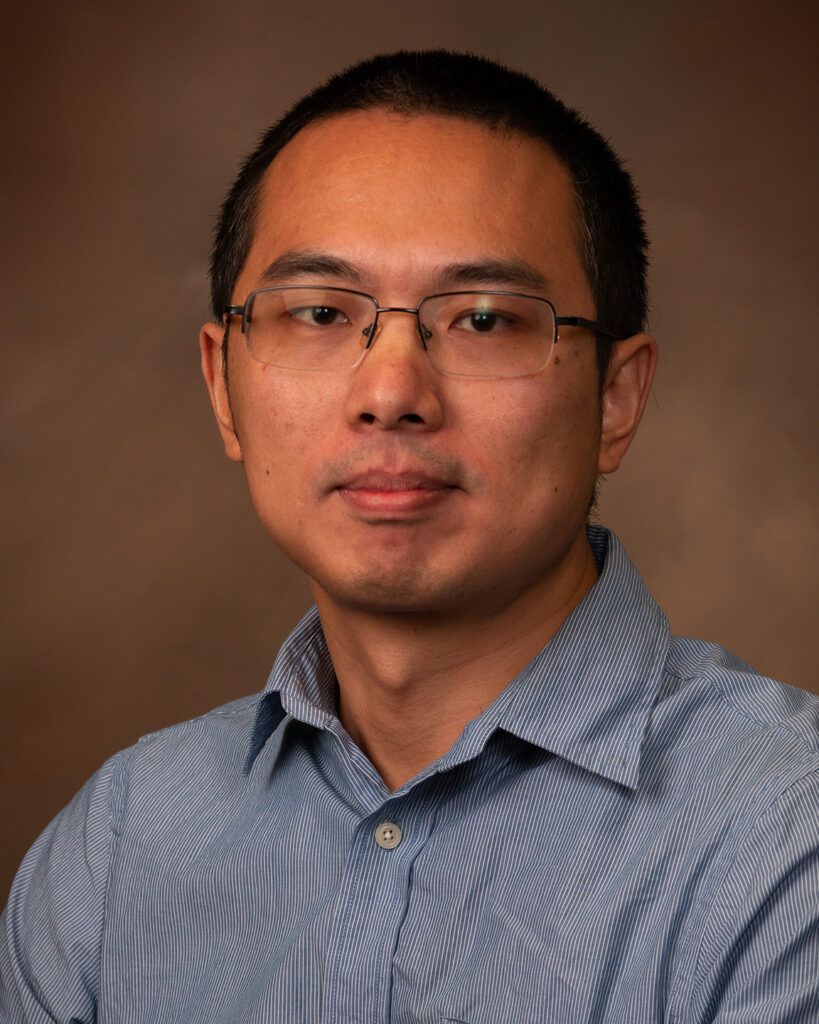To Seed and Grow
Leveraging this momentum, the vibrant health campus chapter has helped seed and grow the undergraduate main campus extension of SACNAS to better address the unique needs of undergraduates in STEM and to develop new leaders. They found enthusiastic support from faculty advisors Naina Phadnis (from the School of Biological Sciences) and Holly Sebahar (Department of Chemistry) along with Rodolfo Probst (postdoc at the College of Science’s Science Research Initiative, or “SRI”). In 2022, with SRI’s Laura Rupert, Probst escorted students to Puerto Rico, where SACNAS held the National Diversity in STEM (NDiSTEM) Conference. It was the perfect environment for students attending the U to connect to and exchange ideas with members and officers from SACNAS chapters around the country. Plus, the national conference created a space for networking with other students and faculty and for opportunities to attend future academic conferences.
“There are different needs between graduate and undergraduate students,” Guzman explains. “And the NDiSTEM Conference has plenty of resources for undergrads. It’s a chance to find mentors and opportunities for summer internships and for displaying our research. The spirit of SACNAS was really embraced by the students that went to Puerto Rico. There was momentum from SRI students and others to get involved with the undergraduate chapter here at the U. I’ve never been to a conference that was more welcoming and warmer!”
The SRI has been directly involved in the development of the undergraduate SACNAS chapter. Many College of Science students are involved in both, with the SRI promoting community adherences to students through shared research labs — similarly to what SACNAS chapters promote for diversity in STEM. “The NDiSTEM in Puerto Rico was planting the seeds,” Guzman says. “We’re providing a nurturing environment.”
SACNAS glue

Rodolfo Probst, post-doctoral researcher and SRI stream leader, in Puerto Rico.
After the Puerto Rico conference, the extension of the SACNAS chapter for undergraduates worked to develop its foundations on campus. In April of 2023, Guzman and Palepoi Gilmore created and hosted a local version of the NDiSTEM conference at the U, where undergraduates were able to present their research, attend professional development sessions, and get better prepared to transition to graduate school.
“Students like Palepoi and Parker, and many others, spearhead and lead all the efforts,” co-advisor Phadnis, states. “These students have organized one event each month during fall and spring semesters, focusing on either community, recruitment, outreach or career building.” Chapter events include socials, outreach, and panels.
“Socials and outreach help foster a sense of belonging,” Probst states. “While panels provide our students with invaluable resources for the next career paths.” To that Guzman adds: “The focus of SACNAS is to build community. You can go and have fun while also talking about school and receiving resources and opportunities. SACNAS is creating a safe and inclusive community where all can thrive.” Faculty advisor Sebahar states, “that was a big part of why I asked to take part.”
SACNAS give students a place to present their research and gain access to resources without the pressures often found in academic spaces. “Sometimes,” says Guzman, “you feel pressure to perform if you're presenting, or as a student, you might feel a sense of hierarchy that is always pervasive.” At SACNAS conferences, however, there is a sense of community and support, alleviating that pressure.
The 2023 NDiSTEM conference, held in Portland, Oregon, proved equally supportive and inspiring. Guzman attended as an officer for the U’s chapter of SACNAS, and Probst and Mikhael Semaan (also an SRI postdoc) went to the conference with SRI students, who presented for the first time at a research gathering.
“I saw this full cycle,” Probst recalls about being at the conference. “There’s a momentum where students come back with full energy. SACNAS is a glue, facilitating this kind of networking and creating a space in which students can go to meetings themselves. That week of being together, traveling together, talking to people from all over the U.S. and finding similar ground,” he continues, addressing prospective SACNAS members, “there’s lots of students doing some really amazing things, from research to outreach, and they want to hear from you. You're going to make great friends; you're going to find great opportunities to network.”
Momentum, a powerful thing
Large, well-known companies and non-governmental organizations participate in SACNAS conferences. Google, NASA, National Geography, and The Nature Conservancy all send representatives to the NDiSTEM conferences as those gatherings provide an amazing recruiting pool for highly capable individuals from diverse backgrounds.
Within the SACNAS NDiSTEM, the hierarchy of higher education STEM in can be circumvented because students present their research, from many different backgrounds, directly not only to peers but to the broader STEM community in both academia and outside organizations.
“The whole environment makes presentations more fluid,” Probst states. “Folks are kinder and engage with purpose. The atmosphere creates that, and it’s a celebration of diversity of backgrounds, research, and ideas.”

SACNAS students at the April 2024 NDiSTEM conference at the U: Alexander Rich, Ainsley Parkins, and Sylvia Lee.
“In STEM, the responsibilities and trust can be highly regimented,” adds Guzman. “Undergraduate students might feel like they can’t participate because they aren’t grad students or postdocs.” SACNAS events facilitate the leveling of that playing field, helping students feel comfortable in taking on responsibilities and research they otherwise might not have access to.
“In undergraduate research, you’re sometimes delegated to doing tasks,” admits Guzman, “instead of being allowed to focus on the bigger picture of what you’re researching.” SACNAS helps open these opportunities, especially students that are historically underrepresented in the sector.
Arguably an uncertain time for organizations like SACNAS in higher-ed where terms like equity, inclusion and diversity are now contested, this unique society remains dedicated to “promoting true diversity and supporting minority and underrepresented students.” The SACNAS chapter at the University of Utah will continue to maintain a space where inclusion and true diversity in STEM is always the first choice. Emblematic of that dedicated mission, earlier this month, the chapter staged the second year of the local NDiSTEM conference, and 116 individuals, including students, speakers and invited guests from all backgrounds and diverse experiences, registered for a full-day interactive meeting.
Momentum is a powerful thing, and as the anthropologist Margaret Mead famously said, “Never underestimate the power of a small group of committed people to change the world. In fact, it is the only thing that ever has.”
This is true of the SACNAS undergraduate cohort at the University of Utah, and true of their president, Parker Guzman, and the faculty advisors devoted to change.


















